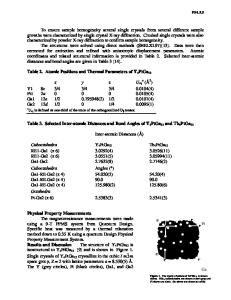Nanostructures and defects in nonequilibrium-synthesized filled skutterudite CeFe 4 Sb 12
- PDF / 576,580 Bytes
- 6 Pages / 584.957 x 782.986 pts Page_size
- 11 Downloads / 755 Views
Xun Shi CAS Key Laboratory of Materials for Energy Conversion, Shanghai Institute of Ceramics, Chinese Academy of Sciences, Shanghai 200050, China (Received 11 December 2010; accepted 22 February 2011)
We studied nanoprecipitates (NPs) and defects in p-type filled skutterudite CeFe4Sb12 prepared by a nonequilibrium melt spinning plus spark plasma sintering method using transmission electron microscopy. NPs with mostly spherical shapes and different sizes (from several nanometers to several tens of nanometers) have been observed. Among these, two types of NPs were most commonly observed, Sb-rich superlattices and CeSb2. The Sb-rich superlattices with a periodicity of about 3.6 nm were induced by the ordering of excessive Sb atoms along the c-direction. These NPs typically share coherent interfaces with the surrounding matrix and induce anisotropic strain fields in the matrix. NPs with compositions close to CeSb2, on the other hand, have been shown to be much larger in size (;30 nm) and have orthorhombic structures. Various defects were typically observed on the interfaces between these NPs and the matrix. The strain fields induced by these NPs are less distinct, possibly because part of the strain has been released by defect formation.
I. INTRODUCTION
The efficiency of a thermoelectric (TE) material is measured by the dimensionless figure of merit ZT 5 S2rT/j, where S, r, T, and j stand for the Seebeck coefficient, electrical conductivity, absolute temperature, and thermal conductivity, respectively.1 The total thermal conductivity, j, includes two parts: the electrical contribution, je, and the lattice contribution, jL, the latter of which can be tuned almost independently of other parameters. Filled skutterudites are typical materials for the phonon glass electron crystal paradigm,2 and they have been shown to exhibit much lower jL than their parent compounds. Filler atoms, such as rare earth,3,4 alkali,5 or alkaline earth6 elements have been utilized to fill the cages of the open-host skutterudite structures to cause localized rattling, superimposed on the collective motions of lattice plane waves, leading to the scattering of heat-carrying acoustic phonons. In addition to filling parent compounds, nanostructuring has been shown to play an important role in reducing the thermal conductivities of a variety of TE materials.7–9 Nonequilibrium synthesis techniques such as rapid solidification and fast sintering are known for producing materials with nanostructures. Recently, a nonequilibrium synthesis method combining melt spinning with subsequent spark plasma sintering (SPS) or hot press has
been successfully used in the preparation of filled skutterudites10–12 and several other TE materials.13–15 Nonequilibrium-synthesized n-type Yb0.2Co4Sb12+y samples with excess Sb have shown dispersion of nanoscale secondary phase on the grain boundaries.12 These nanostructures were believed to have reduced jL and improved the electrical properties at the same time. Nonequilibrium synthesis provides a fast and economical way of processi
Data Loading...











